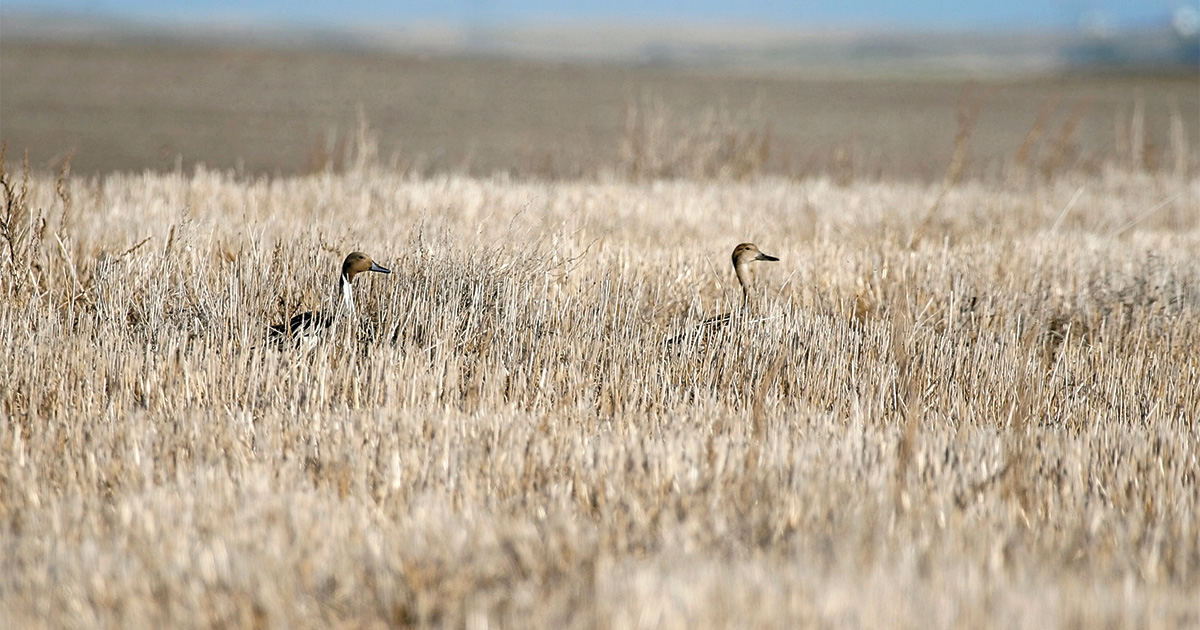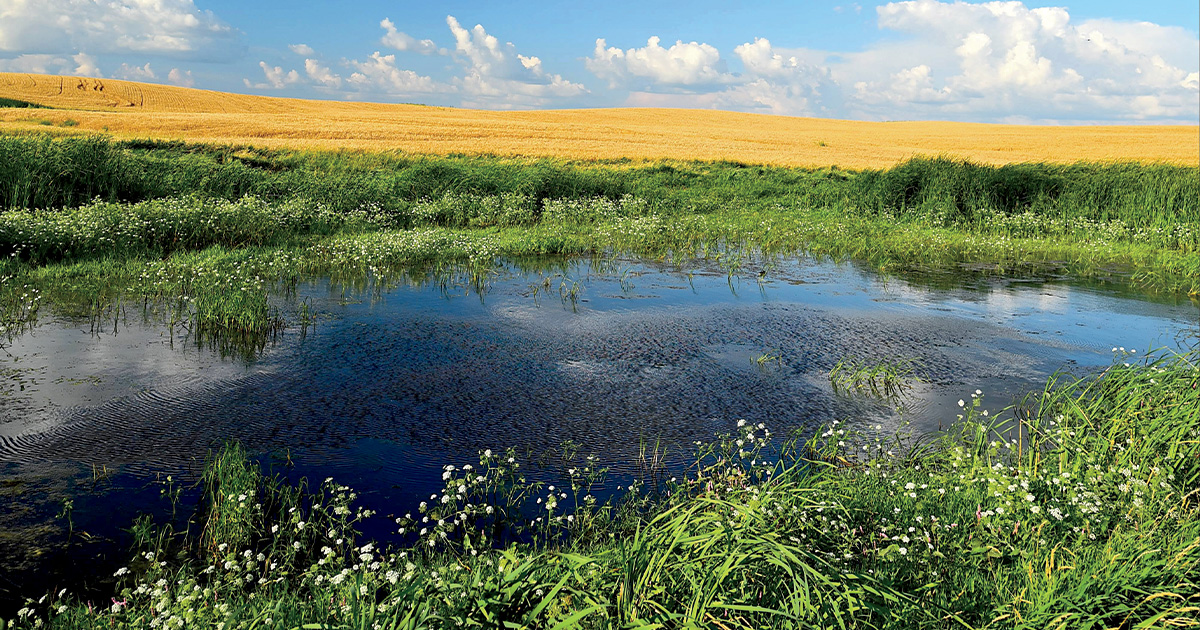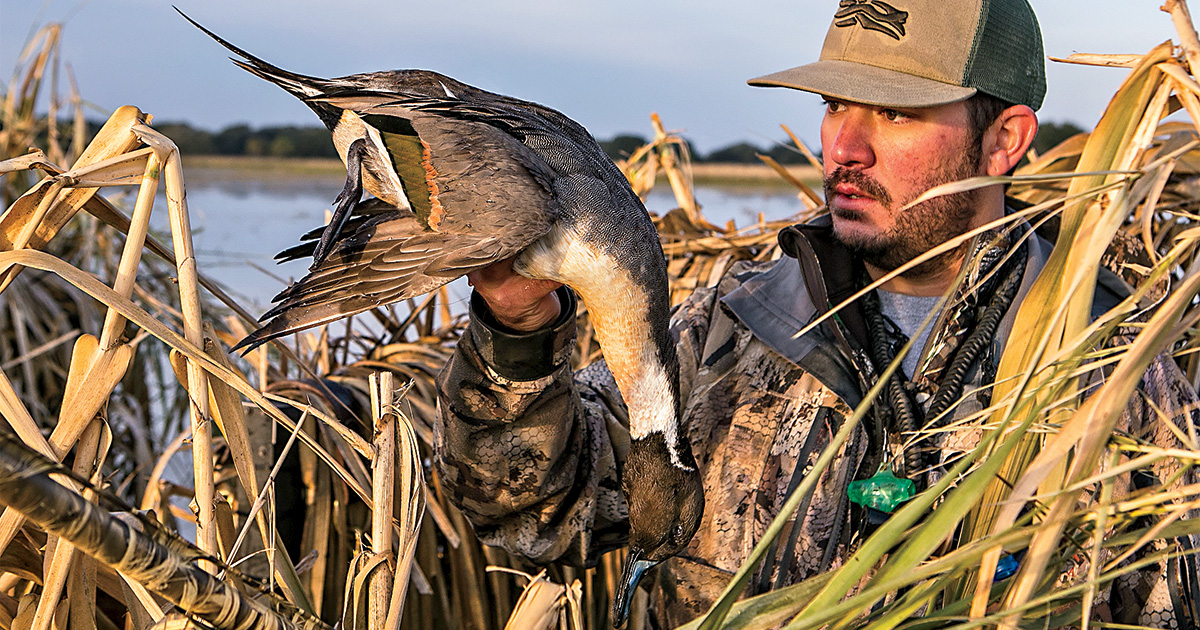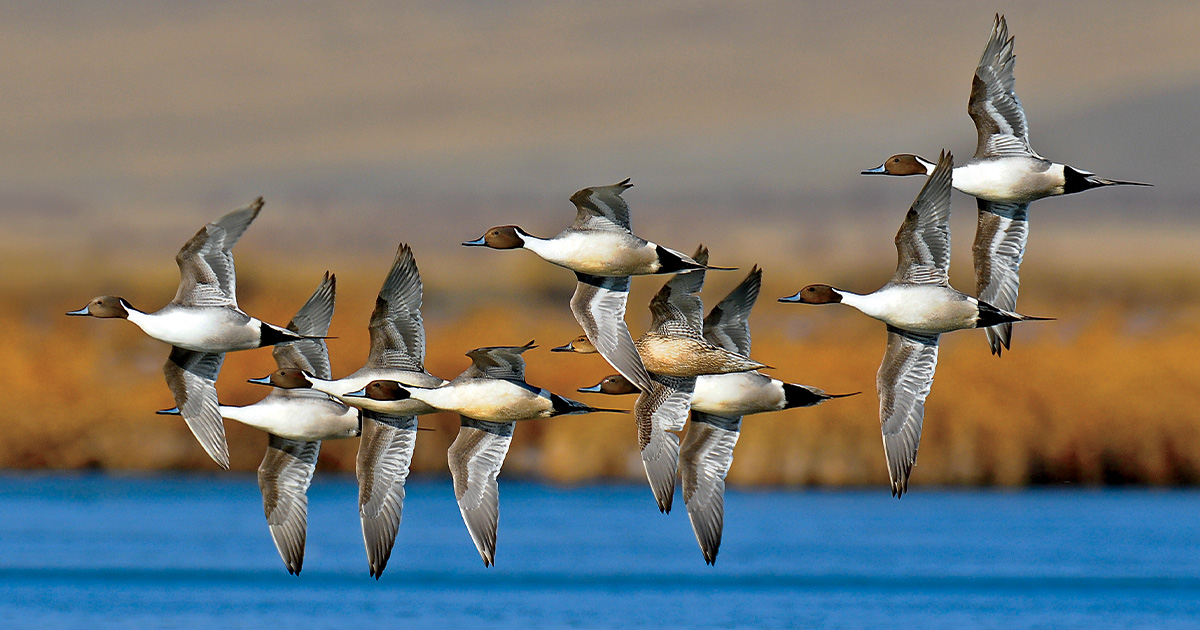DU Special Report: Pintails on the Brink
With a record-low breeding population surveyed last spring, pintails just missed the threshold that would have required a closed season. Following is an update on the status of these highly admired birds
With a record-low breeding population surveyed last spring, pintails just missed the threshold that would have required a closed season. Following is an update on the status of these highly admired birds

We could tell they were pintails. The birds flew on slender wings, and the drakes’ dark chocolate heads, extending far beyond their gleaming white chests and neck bars, seemed oddly disconnected from their bodies. And they all trailed those telltale wedge-shaped tails behind them. That sight never fails to jack the heart rate up a few beats.
Jimmy Robinson sang it out. “Oh, dang, boys,” he said. “Those are pintails.” The attitude shift in the pit was instant. Suddenly, everyone hunkered a little deeper in the blind. Hat brims dipped. No one moved a muscle other than to gingerly raise a whistle to lips and send out a few plaintive trills. Pintails on a beeline. Could we really be so lucky?
The answer to that question, on that day, at that moment, was no. The pintails did as pintails often do. They jetted over the decoys just out of shooting range, ignoring our whistles, oblivious to our pounding hearts and unspoken pleas of please, please, please, come on, please. One more pass and they might have done it. Ten yards closer and we could have given them a try. Instead, the birds crossed over the top of the blind as we all craned our necks to watch them give us the slip.
And that’s the way it is with pintails. Most of the time, they act like wild ducks.

Sticking to the pintail script kept those birds in the sky that Arkansas morning, but doing what they’ve always done is turning out to be a poor strategy in the modern world. It’s a conundrum: As water returned to the Prairie Pothole Region during the wet cycle of the last 30 years, so did many species of ducks. Despite year-to-year fluctuations, most puddle duck populations are holding steady or on an upward trend. Overall, duck numbers are doing remarkably well, thanks to habitat protection and restoration on a continental scale.
Not so with the elegant and beloved pintail. In the mid-1950s, the US Fish and Wildlife Service (USFWS) estimated the continental pintail population was approximately 10 million birds. By 1979, that population had fallen by nearly half, to 5.4 million birds. When a severe drought gripped the prairies during the 1980s, pintail numbers plummeted, bottoming out at a low of 1.8 million birds in 1991. The population partially recovered when water returned to the pothole country in the mid-’90s and then fluctuated in response to changing wetland conditions over the next two decades. There was no data in 2020 and 2021 due to the pandemic-related shutdown of the surveys, but when USFWS pilots took to the skies last spring, they surveyed only 1.78 million pintails across the breeding grounds. That was a record low and 54 percent below the long-term average.
It’s an alarming figure for at least two reasons. First, as compared to the years when upward of 10 million pintails were surveyed in the spring, it signals just how far the numbers have fallen. And second, it suggests just how close hunters came to an entirely closed season on pintails. That 1.78 million figure is perilously close to the federally mandated population floor of 1.75 million pintails. If the population hits that threshold, adaptive harvest management protocols prescribe a closed season on pintails in every flyway the following year.
Which no one wants to see. And while there are no easy answers to the pintail plunge, scientists are teasing apart the factors of nesting ecology, farming practices, and even climate change that are beleaguering the pintail in the 21st century. As Dr. Jim Devries puts it: “Northern pintails are not well evolved for the anthropogenic changes that we throw at them.” Devries is a research scientist with DU Canada, and his dissertation is a deep dive into pintail nesting ecology. What he means is this: At nearly every fork in the evolutionary road, pintails took the wrong turn. Wrong, at least, when it comes to making a living in the modern world.

Let’s start at the literal beginning, with a pintail nest on the grasslands of southern Saskatchewan. Unlike most ducks, which hide their nests in thick cover or even build nests in dense cattails over water, pintails seek out sparsely vegetated nesting sites. In the past, they favored shortgrass prairie, that knee-high blanket of blue grama, buffalograss, and greasegrass that once covered 265 million acres of the western Great Plains. These days, with more than half of that grassland type plowed and planted or otherwise degraded, pintails are more likely to set up shop in a field of last year’s canola, spring wheat, or, if they are lucky, they’ll choose winter wheat. Typically, hen pintails will scratch together a small nest in standing stubble, scraping out a shallow depression in the soil, which they line with collected bits of vegetation and down feathers during the eight- to 10-day egg-laying period. They don’t seek out briary, brambly cover. Pintails have even been known to nest on bare ground like a gull or tern. Choosing to hide in plain sight, as such, the pintail employs a defensive strategy of eyeballing danger from a distance. That long, lean neck that hunters recognize in the sky over the decoys allows pintails to raise their heads above the grass, periscoping the horizon for approaching predators. They are constantly on the lookout for danger at a distance, which might explain why they are so tough to decoy. And when danger does come close, pintails are fairly quick to bolt the nest.
Compounding the problem, nesting pintails prefer to settle near smaller and shallower wetlands than do many other dabblers. Those are the first wetlands to thaw in spring when there is water on the landscape, but in dry years these shallow basins are largely dry. And pintails prefer nesting comparatively far from the closest water. This could be an evolutionary response to avoid getting eaten. Typically, there are more predators patrolling the edges of potholes than there are sniffing around in the middle of an expanse of dry prairie grass. Again, it was a smart way of doing business once upon a time.
Pintails just seem to make it hard on themselves at every turn. They have a propensity to throw in the cards, breeding-wise. Other ducks might try to renest three, four, and sometimes even five times if they lose nests to predators, disturbance, or weather. Not so the pintail. The hen pinnie might try to renest once, but that’s about it. If nest number two fails, the bird will typically pick up and head north to the Arctic for the remainder of the breeding season. “The reproductive potential of pintails is nowhere near that of other birds that will try and try and try again,” says Dr. Steve Adair, DU’s chief scientist.
All of these behaviors and traits create a challenging situation when pintails choose to nest in agricultural fields. In April, just as pintails are arriving on the prairies and establishing nests, many farmers are in their fields as well, seeding the next crop. Research in Canada has shown that about half of all pintails nest in cropland, and of those, 95 percent will fail to produce any ducklings due to predation and mechanical disturbance. That’s an incredible number of pintails that never make it into the sky.

The situation is different in the Pacific Flyway. There, many pintails nest in Alaska on protected wetlands that are largely undisturbed by people. A warming trend “has made Alaska more friendly for breeding dabbling ducks across the last half century,” says Dr. Mark Petrie, director of conservation planning in DU’s Western Region. But birds on the flyway’s wintering grounds have an increasingly difficult row to hoe. California’s water crisis is a waterfowl crisis. Much of both California and Oregon is still in drought despite some improvement over the winter. “Right now, there’s no doubt that pintail populations are impacted most by conditions on their breeding grounds,” Petrie says. “But long term, there are issues on the wintering grounds that could cause problems.”
It’s a challenging calculus. Each pintail nest on the prairie lies at the intersection of a number of troubling factors—a changing climate, a challenging agricultural landscape, and the handcuffs of evolutionary history. You can’t blame the pintails. They’re only doing what they’ve always done, and that’s not going to change any time soon. So, it’s up to us to find “the next big idea for pintails,” according to one researcher.
Unfortunately, that has proven difficult so far.
Bringing back pintails and conserving the current population will require more pintail-friendly breeding habitat. It’s helpful to think about the places where pintails successfully nested in the recent past, during the 1970s. Back then, many Canadian farmers utilized a technique called summer fallow, leaving 30 to 40 percent of their fields unplowed and unseeded each year. The practice helped retain soil moisture and boost nutrient inputs due to the breakdown of existing vegetation and provided relatively undisturbed pintail nesting habitat. But new seed varieties and market pressures pushed farmers to seed all of their fields every year. Within a few years, 25 million acres of relatively safe pintail breeding habitat vanished, and pintail numbers nose-dived.
Now conservationists are looking for new ways to keep farm equipment out of prime pintail nesting habitat in early to late spring. “Conversion of cropland back to grassland is ideally what we’d like to see,” Devries says. “But Canada doesn’t offer a Conservation Reserve Program approach, and farmers are always under the pressure of commodity prices.”
In the past, DU Canada has worked with researchers at the University of Saskatchewan to develop particularly cold-hardy winter wheat varieties, which are seeded in the fall, thus avoiding destruction of nests by seeding operations. And pintail nest survival is higher in winter wheat than in any other agricultural habitat, Devries says. Hybrid rye varieties are also an option for a compatible fall-seeded crop. And more recent efforts in Alberta are looking at ultra-early seeding of spring wheat in March and April, when soil temperatures are just above freezing and before any pintails are nesting. All these options give birds a chance to nest and hatch a brood in cultivated cropland before harvesting begins.

But developing new seed varieties takes time, not to mention the laborious process of helping farmers adopt new practices on a scale that could positively impact the population of a bird that breeds in some of the most fertile agricultural lands on the continent. “The key we haven’t been able to find is how to make cropland more friendly for nesting pintails,” Adair explains. “Is there something we can discover that can be widely adopted? So far, that’s been elusive.”
If solutions can’t be found, hunters could pay an unwelcome price. Pintail harvest limits have already been cut, and based on the 2022 survey estimates, “we just missed having a closed season on pintails in 2023−24,” explains Adair. “That was pretty shocking.”
It was a close call, but there is reason to be optimistic that pintail numbers will rise in the short term. As of press time, much of Prairie Canada was still on the dry side, but snowpack in the Dakotas was in great shape. It augers well for the upcoming pintail breeding season. “With a good portion of the prairies being wet last spring, we dodged that bullet of a closed season,” Adair notes. “I think pintails are going to bounce back a bit this spring if we have enough water on the prairies.” And that may be as good as it gets for the next few years.
But miracles happen. Wet years could return. Breakthroughs in crop science are announced every day. And until some quantum leap in crop varieties or farming methodology occurs, the hard work of conservation will hold back the dam on pintail numbers. That means doing more of what Ducks Unlimited is already doing: working with every farmer and rancher we can, talking to every policymaker who will listen, and fighting for every acre of wetlands.

Hunters also have an important role to play in a recalibrated relationship with the northern pintail. The challenges facing this revered duck are significant. A sober view of its plight should prompt waterfowlers to consider a new possibility. “The declines aren’t as steep anymore,” Devries explains. “If we can’t work out the productivity issues, it may be that pintails simply level out.” If that’s the case, duck hunters and other waterfowl enthusiasts will be the ones to adapt to a new reality.
Which shifts some of the burden south from Prairie Canada and the greater Prairie Pothole Region to that Arkansas pit blind, where the sight of seven pintails winging overhead struck my pals and me silent. Looking back, I’m optimistic that our silence wasn’t only in the hope that those birds would circle back to our decoys, but also a sort of pledge that we wouldn’t give up on the pintail in general.
A new pintail paradigm may mean that hunters learn to leave the field not with a heavy bag, but with a full heart. Those empty rings on the duck strap are there to remind us of the ebb and flow of waterfowl populations and to prompt us to recommit ourselves to conservation efforts that will make our world a little more inviting for the world’s most elegant duck.
Ducks Unlimited uses cookies to enhance your browsing experience, optimize site functionality, analyze traffic, and deliver personalized advertising through third parties. By continuing to use this site, you agree to our use of cookies. View Privacy Policy